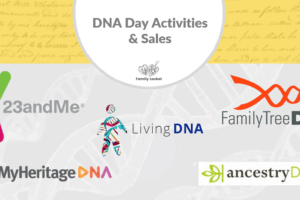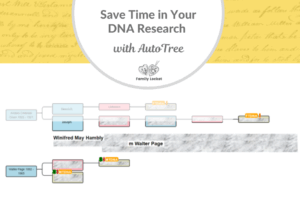When is the last time you went outside of your genealogical comfort zone and learned something unrelated to your usual research area? One of my favorite sayings is, “you don’t know what you don’t know.” That statement especially holds true for genealogy. Attending the BYU Conference on Family History and Genealogy last week, I decided to try out some classes in areas where I’m not a specialist and find out what I didn’t know.
I attended classes by experts Peggy Lauritzen, Curt Witcher, Paul Woodbury, and Dan Poffenberger. Topics included Ohio Land, Native American research, Best Practices for DNA, and Irish research. Was it a valuable use of my time? Absolutely. It’s good for us to stimulate our brains and learn something new. Regardless of the topic, we can make connections to our own research brick walls and get ideas of how to solve them.
Today I’m sharing a snippet from each presentation and giving you my take on how to use the information to become a better researcher.
Peggy Lauritzen: “Ohio, The Great Land Experiment”
Miss Peggy gave us an entertaining hour learning about the history of the northeastern United States and the migration of easterners into Ohio. Her use of maps reminded me of the importance of learning about location. Ohio land was distributed by both the state (metes and bounds) and the federal government (rectangular system). In Peggy’s words, a mess for the researcher but not insurmountable.

Source: “Ohio Lands” in Wikipedia: the Free Encyclopedia at http://en.wikipedia.org/wiki/Ohio_Lands (accessed 11 February 2012) citing the National Atlas of the United States.
The Ohio land map of the various grants, tracts, districts and cessions is invaluable to understanding how your ancestor might have received land. The FamilySearch Research Wiki article “Ohio Land and Property” gives excellent information about each distribution. Peggy demonstrated the website Earth Point to locate any township and range on Google Earth, a useful tool to pinpoint your ancestor’s historical location on a current topographical map.
TIP: Dive into the history and maps of your research locality. An hour or two spent in learning will reap dividends in your understanding of the area and help you further your research.
Check out Peggy Lauritzen’s website here.
Paul Woodbury – “DNA Best Practices”
I was hoping to get some good ideas on how best to approach my DNA results and Paul’s class didn’t disappoint. He covered four main points.
Publication: I learned that there is a lot we can do to make ourselves more approachable on the DNA websites – upload a profile picture, add a surname list, and attach a family tree to our results. We may like to remain anonymous, but that isn’t going to encourage our matches to correspond with us.
Organization: Tools that we use to organize our genealogy can also be used to organize our DNA results. Think research logs, tables, charts, research reports, family group records. Stay tuned – I’m going to experiment with these then I’ll share my experiences.
Collaboration: We all understand the importance of sharing photos, stories, and documents with other researchers. What goes around, comes around. The same principle holds true with DNA matches. The more we’re willing to share with our new cousins, the more information they will share.
Identification: How do we combat the invisible matches? Paul suggested building trees for matches using traditional documentary evidence. Helpful sources are city directories, census records, tax, records, land records and newspapers. Public records on Whitepages, Intellius, Spokeo, and Been Verified can help us to identify our matches.
TIP: Attach a profile picture of yourself to your DNA profile. Your matches will be more likely to reply to your messages if they see who you are.
Read more about Paul Woodbury here.
Curt Witcher: “Native American / First Nations Genealogical Research”
Curt’s class gave me many insights into Native American research. He stressed the importance of putting our research in the context of history, geography and time. We must understand the Native culture that we’re exploring. Start with general histories and records of the area to discover the tribes that were in the area. Seek to establish a tribal affiliation then search for tribe specific data. Once the tribe has been established, research specific individuals.
I left the class wanting to dig into a project and put my newly learned ideas into practice.
His three step process to determine native tribe of an ancestor:
– Make a thorough investigation of the early area to discover histories, identities, and other information on the Native people of the area.
– Locate the greatest number of documents and data on the tribe of a potential ancestor.
– Work through the date to Intensely study the tribe or nation and gain knowledge
TIP: Research the intruders: settlers, soldiers, traders and trappers, government agents, and missionaries. These individuals left records naming specific Native Americans. (This sounds a lot like FAN club research).
Read more about Curt Witcher here (scroll to the bottom of the page).
Dan Poffenberger: “Intermediate Irish Research: Because There’s No Such Thing As Beginning Irish Research”
I attended both of Dan’s sessions and received a solid understanding of the ins and outs of Irish research. My main take-away – although record loss is significant, five strategies will aid you in your search.
– Start with the straightforward searches – passenger lists, census records, naturalization records\
– Leave no stone unturned – find everything you can about your ancestor’s life in the country they immigrated to
– Use the cluster migration strategy – where did their extended family and friends come from?
– Surname distribution can get you started on determining a locality for your ancestor- works best if the surname is less common.
– DNA is becoming more and more useful. The ISOGG Ireland Wiki is a good place to start.
TIP: Understand the civil parishes and Catholic parishes whereever you’re researching. Your ancestor’s records could be in various jurisdictions.
Click here to learn more about Dan Poffenberger.
These four classes were just a few of the many I attended. Without fail, I picked up a new research tip or was reminded of an important methodology. Some of the most valuable time we can spend as genealogists is an hour or two learning something new.
Just for fun, try watching a webinar or attending class on a topic outside your research focus. I think you’ll be pleasantly surprised! Need some ideas of where to find webinars, check out my post “The Wonderful World of Webinars.”
Best of luck in all of your family history endeavors!














Leave a Reply
Thanks for the note!